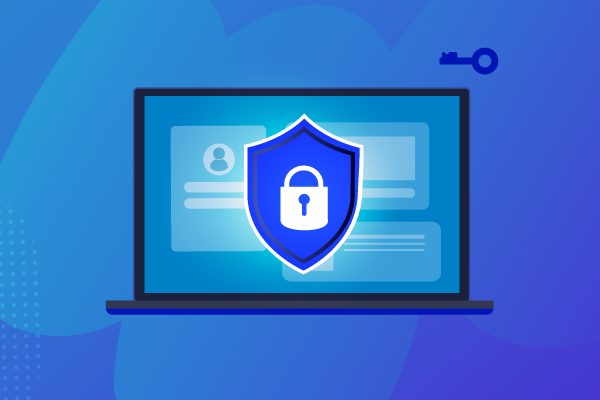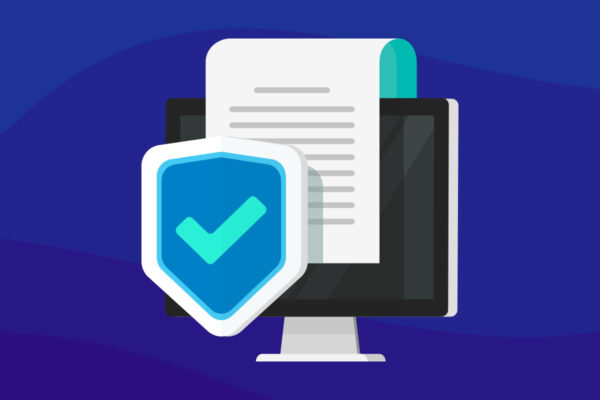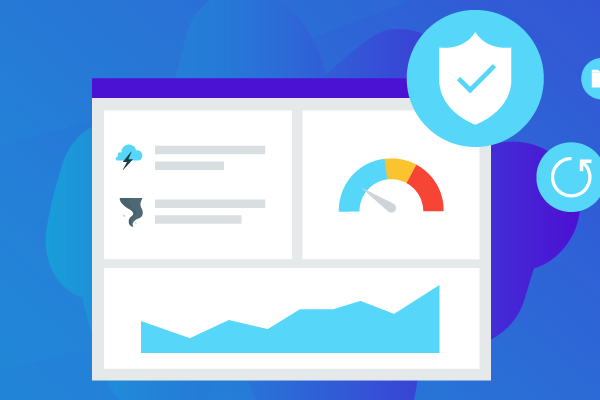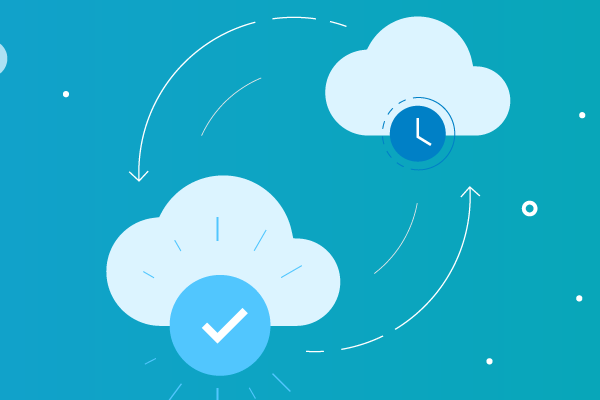What is BCDR? Building resilience with business continuity and disaster recovery
Organizations today operate in an environment shaped by constant risk. From ransomware attacks and extreme weather events to insider threats and accidental data deletions, disruptions can strike from any direction — external or internal. And when they do, these events can grind operations to a halt, corrupt or erase business-critical data, damage customer trust and cause significant financial losses. That’s why more organizations are shifting away from traditional backup-only strategies to adopt comprehensive business continuity and disaster recovery (BCDR) approaches that protect not just data but the business itself.
BCDR has become a critical component of every IT management and security strategy, enabling businesses to maintain operations during disruptions and recover quickly afterward. In this blog, we’ll break down what BCDR really means, why it plays a critical role in strengthening operational resilience and how you can build an effective BCDR plan. You’ll also discover how solutions like Datto BCDR are built to help businesses stay resilient in the face of evolving modern threats.
What is BCDR?
Business continuity and disaster recovery is a strategic framework that brings together people, technology and processes to ensure that an organization can continue operating — or quickly resume critical functions — when disruptions occur. Whether the event is a cyberattack, natural disaster, system failure or human error, BCDR is designed to limit downtime, reduce data loss and safeguard business performance.
At its core, BCDR unites two closely related but distinct disciplines: business continuity and disaster recovery. While they serve different purposes, they work hand in hand to support a resilient organization.
Business continuity
Business continuity focuses on proactive planning to maintain essential business functions during and immediately after a disruptive incident. It’s about ensuring the business can continue delivering products or services, even if some parts of the system are compromised.
This involves identifying mission-critical operations, setting up alternative workflows and preparing teams to respond quickly when normal procedures are disrupted. The aim is to keep operations flowing and minimize the impact on customers, partners and revenue.
Key components of business continuity include:
- Identifying and prioritizing essential operations and processes
- Creating contingency plans to prevent or reduce downtime
- Maintaining customer service, supply chains and communication
- Ensuring compliance with regulatory and contractual obligations
- Establishing alternative work locations and remote access protocols
- Regular testing and updating of business continuity plans
By focusing on continuity rather than just recovery, businesses can stay agile and maintain trust during turbulent times.
Disaster recovery
Disaster recovery focuses on the technical side of getting back to normal. It involves restoring IT systems, infrastructure and data after an incident. This could mean recovering files after a ransomware attack, rebuilding servers after a hardware failure or spinning up virtual machines (VMs) from backups.
While business continuity keeps the business running, disaster recovery makes sure the technology that supports it can be restored quickly and securely.
Key components of disaster recovery include:
- Reliable data backup and rapid data restoration processes
- Redundant infrastructure and off-site recovery environments
- Automated or orchestrated recovery for critical systems
- Clear incident response and communication protocols
- Recovery time objectives (RTOs) and recovery point objectives (RPOs)
- Continuous monitoring and regular disaster recovery testing
Disaster recovery plays a critical role in minimizing data loss and ensuring that IT systems are available when they’re needed most.
Why is BCDR important?
A well-planned BCDR strategy empowers organizations to withstand unexpected disruptions, protect critical assets and continue operating in the face of adversity. Without it, businesses are left vulnerable to prolonged outages, permanent data loss, regulatory violations and reputational damage.
A BCDR approach supports organizational resilience across three key areas: reducing downtime, protecting data integrity and preventing financial and reputational damage.
Minimize downtime and operational disruption
Even short outages can interrupt service delivery and affect revenue. BCDR helps sustain critical functions, reduce recovery time and prevent isolated issues from spreading across departments.
Let’s say a manufacturing company is hit by a ransomware attack that takes down its production management system. A solid BCDR plan allows the company to restore systems from clean backups and resume operations quickly. Without it, production could stall for days, leading to missed deadlines and revenue loss.
Maintain data integrity and compliance
Regulatory frameworks like the General Data Protection Regulation (GDPR), the Health Insurance Portability and Accountability Act (HIPAA) and the Payment Card Industry Data Security Standard (PCI-DSS) require organizations to secure data and ensure availability. BCDR plays a key role in meeting these obligations by enabling secure, consistent data backups and timely recovery.
Consider a financial services firm that experiences a database failure. With automated backups and recovery workflows in place, the IT team can restore records in minutes, avoiding data loss and staying within compliance windows. BCDR not only helps protect sensitive data but also supports audit readiness and reduces the risk of legal or regulatory consequences.
Avoid reputational damage and financial Loss
Downtime and data loss come with steep costs — not just operational, but reputational as well. Delays, outages and lost access can erode customer trust and trigger penalties or lost contracts.
Imagine a healthcare provider that loses access to its patient management system due to a data center outage. With a BCDR plan in place, critical applications can be quickly brought online through cloud-based failover systems. Patient records remain accessible, appointments continue and care is delivered without delay. However, without a BCDR plan, the same outage would have meant cancelled appointments, inaccessible medical records and communication breakdowns across departments. The result? Frustrated patients, potential legal exposure and long-term reputational damage.
Responding swiftly keeps issues contained and protects brand credibility at a time when reputations can shift quickly.
Want to discover how BCDR fits into your cybersecurity strategy? Download The Ultimate Guide to BCDR for actionable steps to building a resilient, recovery-ready business. It’s designed for IT teams and decision-makers who want to keep operations moving no matter what.
What is a BCDR plan?
A BCDR plan is a documented strategy that outlines how a business will maintain essential operations and recover critical systems during or after a disruption. It’s tailored to the organization’s size, structure, risks and compliance requirements.
More than just a checklist, a BCDR plan brings together people, processes and technologies to ensure readiness for a wide range of disruptions. In the sections below, we’ll look at the types of risks it addresses, the process of building a plan and the tools that support its execution.
What risks does a BCDR plan account for?
A comprehensive BCDR plan helps businesses prepare for a wide range of threats that could otherwise bring operations to a standstill.
- Cyberattacks and security incidents: Threats like ransomware, phishing or data breaches can corrupt, encrypt or expose sensitive data. A BCDR plan enables rapid recovery from verified, immutable backups and ensures critical services stay online while investigations and containment efforts take place.
- Hardware and software failure: System crashes, disk corruption or failed software updates can stop operations. BCDR plans prepare for these failures with full system imaging, redundant infrastructure and rapid restore capabilities that get teams back online without waiting for physical repairs.
- Human error and insider threats: Employees may delete data, misconfigure systems or fall victim to phishing. In the worst cases, malicious insiders may cause intentional damage. BCDR protects against these scenarios with frequent backup snapshots and rollback features, allowing businesses to recover affected systems or data with minimal downtime.
- Natural disasters and infrastructure loss: Events like floods, storms and fires can destroy office locations and on-premises systems. BCDR plans mitigate these risks by enabling failover to secondary data centers or cloud infrastructure, allowing employees to work remotely and operations to continue even if the main site is offline.
- Power outages and network disruptions: Loss of electricity or internet access, even for a brief period, can halt digital operations. BCDR plans account for this with off-site recovery environments, cloud-hosted backups and alternate access points, so employees can continue working without interruption.
How to build a BCDR plan
Creating a BCDR plan is not a one-size-fits-all task. It’s a structured process that considers business priorities, risk exposure and technical capabilities. Here’s how to build one step by step:
1. Understand recovery objectives (RTO & RPO).
Start by defining your recovery time objective and recovery point objective.
- RTO is how quickly systems and services need to be restored.
- RPO is how much data loss a business can tolerate, measured in time.
These objectives shape the entire BCDR strategy. For example, a healthcare system might require near-zero RPO to avoid losing patient data, while a marketing agency might tolerate longer windows.
Use the Recovery Time & Downtime Cost Calculator to understand how much downtime could cost your business or your clients.
2. Conduct a business impact analysis (BIA) to assess risks.
A BIA helps you identify the critical functions a business depends on and what happens if they go down. It provides a clear picture of operational, financial and reputational impacts.

Fig 1: How to conduct a BIA
3. Identify potential downtime and disaster scenarios.
Look at both likely and high-impact events — cyberattacks, natural disasters, tech failures and internal threats. Understanding scenarios helps you prioritize planning and allocate resources.
4. Outline recovery strategies and solutions.
Define how the business will restore operations in each scenario. This might include:
- Backup scheduling and retention policies
- Cloud failover or virtualization
- Alternate office locations or remote work capabilities
- Vendor or partner agreements to support recovery
5. Define roles and responsibilities.
Every BCDR plan needs a team with clearly assigned duties. From executive sponsors to IT leads and department heads, everyone should know their role during a disruption and how decisions will be made.
6. Develop business continuity and disaster recovery procedures.
Write detailed, step-by-step procedures for how to continue operations and recover systems. These should be easy to follow, accessible during emergencies and regularly reviewed by those involved.
7. Review and update with BCDR testing.
Plans are only effective if tested. Run simulations, conduct tabletop exercises and adjust plans based on gaps or changes in your environment. Regular reviews ensure your BCDR plan evolves with the business.
What are BCDR solutions?
BCDR solutions are designed to help businesses implement, automate and manage business continuity and recovery strategies more efficiently. These platforms handle critical tasks like data backup, verification, virtualization and orchestration, all from a single interface.
Instead of managing manual backups or fragmented recovery processes, BCDR solutions allow IT teams to execute recovery plans quickly and confidently. They reduce recovery time, improve data integrity and ensure that systems can be restored within defined RTOs and RPOs. These solutions are essential for organizations that need to guarantee uptime, meet compliance standards and recover from incidents without disruption.
Build resilience with Datto BCDR
Whether you’re an MSP managing multiple client environments or an internal IT leader responsible for protecting your organization, Datto delivers reliable, scalable and easy-to-manage BCDR solutions designed to keep business operations running, no matter what. Datto combines advanced, immutable backup features with flexible recovery options to help organizations minimize downtime, recover faster and maintain confidence during any disruption.
Here’s what you get with Datto BCDR:
- Instant virtualization: Datto enables instant virtualization locally, in the cloud or both. If your on-site systems go down, Datto appliances act as a local recovery target so you can spin up systems right on the device. If local recovery isn’t an option, Datto BCDR Cloud lets you virtualize systems off-site, restoring operations in minutes.
- Screenshot and application verification: Automated screenshot verification confirms that backups are bootable and recoverable. Beyond the image, Datto also checks that critical applications start properly after a restore, giving you confidence that your recovery will work when it matters most.
- Built-in ransomware resilience: Datto BCDR is designed from the ground up to deliver superior protection against cyberthreats like ransomware. Backups are stored in the write-once-read-many (WORM) format, so they can’t be altered or encrypted even by admins. Linux-based appliances reduce exposure to common Windows-based threats, while built-in ransomware detection alerts IT teams to suspicious activity early.
- Flexible recovery options: Datto gives IT teams the flexibility to restore data exactly how they need to. Whether it’s a single file or an entire system, recovery options include file/folder restore, volume restore, full-system virtualization, ESX upload and bare metal restore — on your terms, in your environment.
Datto BCDR helps IT teams stay ahead of threats, respond with speed and reduce business risk. Ready to see how Datto BCDR can help you maintain business continuity through any disruption? Learn more about Datto BCDR here.




